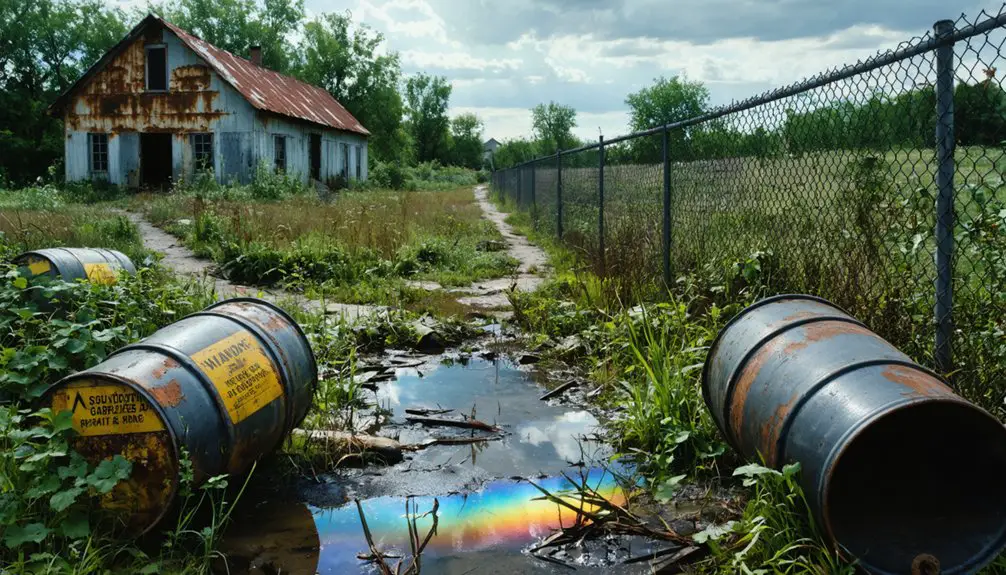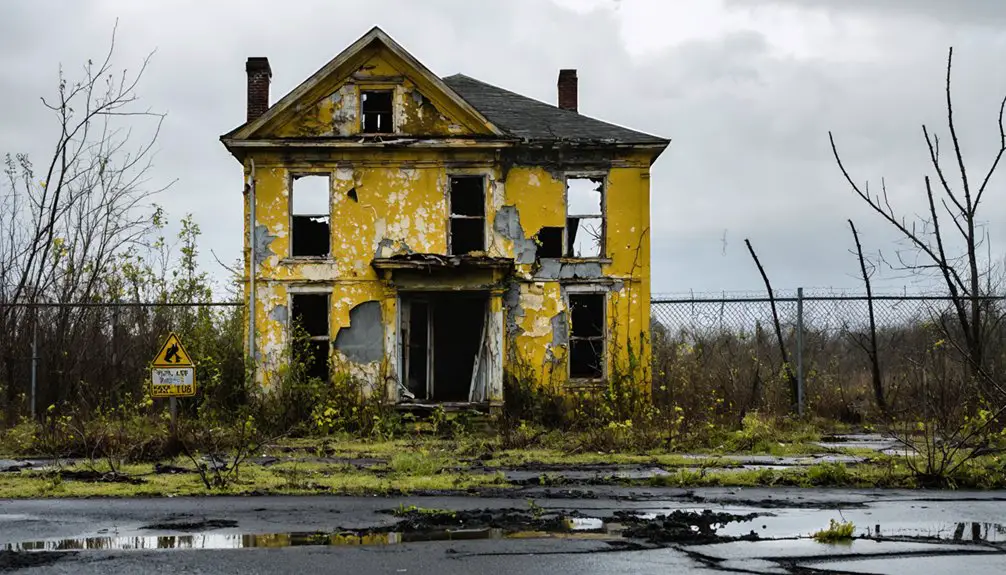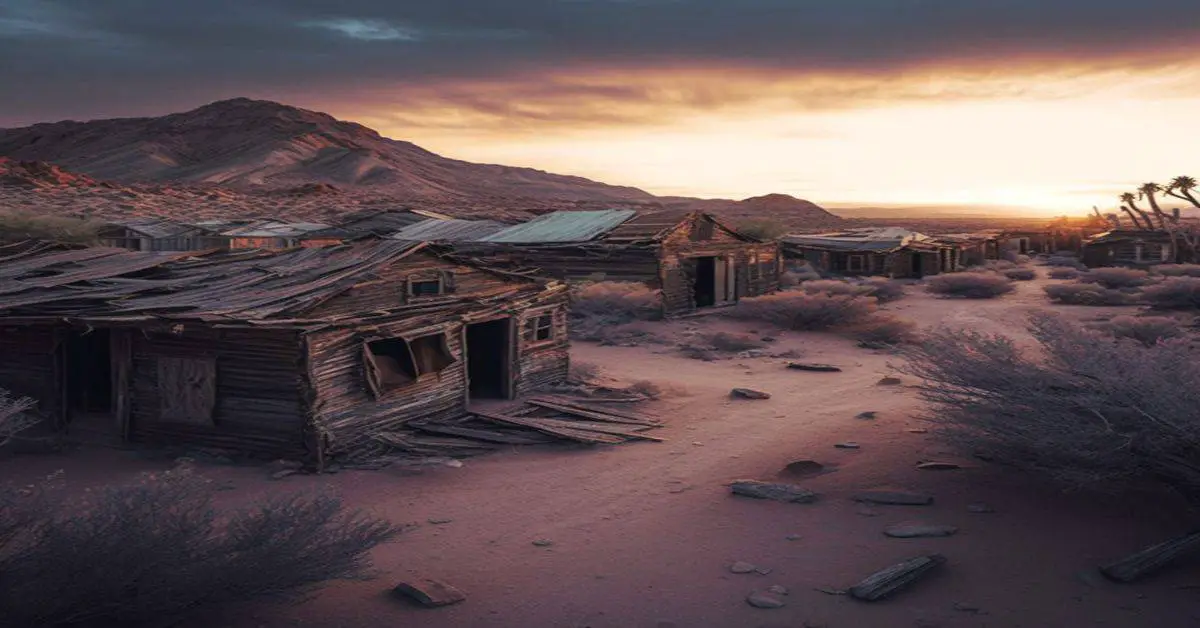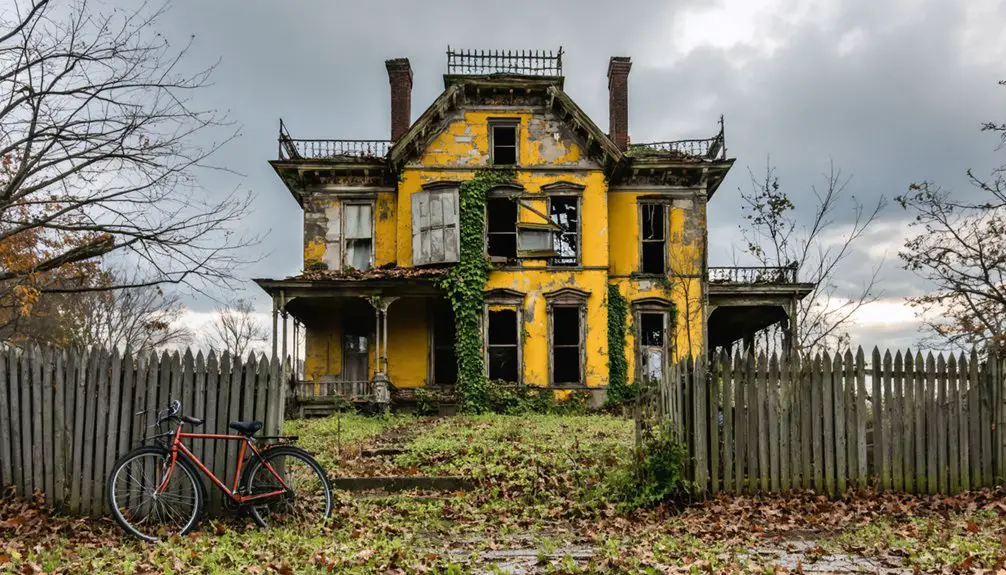You’ll find Love Canal‘s tragic tale in Niagara Falls, NY, where William T. Love’s dream of an industrial paradise became America’s worst environmental disaster. In the 1940s, Hooker Chemical dumped 21,800 tons of toxic waste into Love’s abandoned canal before selling the land for $1. The subsequent construction of homes and schools atop this chemical cocktail led to severe health issues, forcing a mass evacuation that transformed a thriving community into an uninhabited warning about industrial negligence.
Key Takeaways
- Love Canal became a ghost town in 1978 when residents evacuated due to toxic waste contamination from 21,800 tons of chemicals.
- The New York State government purchased and demolished over 800 contaminated homes, creating a largely vacant area.
- A 70-acre section was fenced off and declared uninhabitable, with only remnants of streets and foundations remaining.
- Most residents relocated through government buyouts, leaving behind a once-thriving neighborhood turned toxic wasteland.
- Today, parts of Love Canal remain abandoned, though some areas were revitalized after extensive environmental cleanup efforts.
The Dream of William T. Love’s Industrial Paradise
In the twilight of the nineteenth century, William T. Love envisioned an industrial paradise that would harness the raw power of Niagara River. His industrial ambition aimed to create Model City, a meticulously planned community where factories would thrive on cheap hydroelectric power generated by a massive canal system.
You’d have witnessed Love’s community vision unfold through carefully designed streets, parks, and residential areas surrounding an ambitious seven-mile canal. This waterway would’ve diverted Niagara’s flow, creating a shipping route between Lakes Erie and Ontario while powering countless factories. His plan incorporated free land for businesses to attract industry while maintaining affordable housing for workers. Unfortunately, after digging only one mile of the canal, the project was abandoned by 1910.
With backing from prominent financial institutions across New York, Chicago, and England, Love’s dream promised to revolutionize American industry. He’d convinced investors that his canal would double Niagara’s hydroelectric output, transforming the region into an unstoppable industrial force.
From Swimming Hole to Chemical Dumping Ground
After Love’s grand canal project collapsed in 1894, the abandoned waterway transformed into an unlikely community gathering spot where local residents found respite from industrial life.
A failed industrial dream unexpectedly birthed a communal oasis, where locals escaped the grinding pace of factory life.
The site’s recreational history included swimming in summer and ice skating in winter, demonstrating remarkable community integration despite its industrial origins.
This period of communal enjoyment came to an abrupt end when Hooker Chemical Company began using the canal as a dumping ground in 1942.
Over the next decade, they buried 21,800 tons of toxic chemicals, including benzene, dioxins, and PCBs.
The site was then sealed with clay and cement before being sold to the school board for $1 in 1953.
You’d never know that beneath this seemingly secure cap lay a toxic legacy that would soon devastate an entire community.
The school board proceeded to build 93rd Street School directly on the contaminated property, ignoring the chemical company’s liability disclaimer.
By 1978, scientific testing revealed 82 chemical compounds seeping through the soil, marking the beginning of a public health crisis.
Hooker Chemical’s Toxic Legacy
While the abandoned Love Canal initially served as a community gathering place, its transformation into an industrial waste site by Hooker Chemical Company in 1947 marked the beginning of an environmental catastrophe.
Over five years, the company dumped nearly 22,000 tons of toxic chemicals into the 16-acre landfill, creating a devastating toxic legacy that would haunt future generations. Tests revealed 82 chemical compounds contaminating the area, including numerous carcinogens.
You can trace Hooker’s environmental negligence through their actions: burying hazardous waste in deteriorating drums, using inadequate clay seals, and selling the contaminated land to the school board for $1 with a liability waiver. After the sale, the Niagara Falls School Board constructed an elementary school directly on the toxic property.
The consequences proved catastrophic when chemicals began leaching into soil and groundwater, creating a hellscape of chemical burns, cancers, and birth defects that forced residents to abandon their homes, transforming a once-vibrant community into a ghost town.
The $1 Land Deal That Changed Everything
Through what appeared to be a simple property transaction, Hooker Chemical’s sale of Love Canal to the Niagara Falls Board of Education for $1 in 1953 became one of America’s most consequential land deals.
You’ll find this wasn’t just about transferring ownership – it was about shifting responsibility. The company included a liability disclaimer in the deed, washing their hands of future damages from the toxic waste buried beneath.
The aftermath challenged notions of environmental justice as the working-class neighborhood grew to 800 homes and two schools, built directly atop the chemical landfill. The site contained 88 different chemicals that had been dumped there between 1942 and 1953.
When toxins began seeping into basements in the 1970s, community resilience emerged through activist groups demanding action.
This pivotal deal ultimately sparked national environmental reforms, leading to the creation of the Superfund Program and stricter waste management laws.
Building a Community on Hidden Dangers
You’d find it hard to believe that over 800 homes and two schools were built directly above 21,800 tons of toxic industrial waste at Love Canal during the late 1950s.
The community’s growth proceeded despite early warning signs in 1958 when children suffered chemical burns from exposed contaminants seeping through their yards and basements.
Your new neighborhood’s seemingly normal streets masked a deadly reality – chemical waste slowly leaching into the soil and groundwater beneath your feet, creating an invisible threat to everyone who called Love Canal home.
The land had been sold to the Board of Education by Hooker Chemical Corporation in 1953 for just one dollar, with clear warnings about the buried chemicals that went unheeded.
Homes Above Toxic Waste
After Hooker Chemical sold the contaminated Love Canal property to the local school board for a mere dollar in 1953, developers began constructing over 800 homes and two elementary schools directly atop a massive toxic waste site.
You wouldn’t have known that beneath your feet lay nearly 22,000 tons of industrial chemicals slowly leaking from corroding drums into the soil where your children played.
This toxic legacy expanded as construction crews installed storm sewers, roads, and utilities, unknowingly disturbing the chemical landfill below.
Despite early warning signs of environmental negligence in 1958, when local health authorities documented children’s chemical burns, development continued.
Your neighborhood was built above thousands of deteriorating drums containing solvents, acids, and chlorinated hydrocarbons – a deadly cocktail that would eventually force most residents to abandon their homes.
By 1976, residents reported severe health problems including skin rashes and respiratory ailments as chemicals seeped into their basements and yards.
The area’s transformation from a prosperous neighborhood to a contaminated wasteland became a stark symbol of environmental disaster.
Residents Discover Deadly Ground
When residents of Love Canal first noticed puddles of strange-colored water and noxious odors seeping into their yards in the early 1970s, they couldn’t have imagined the full horror lurking beneath their homes.
Your peaceful neighborhood transformed into ground zero for environmental justice as corroding waste barrels surfaced, releasing 82 toxic chemicals including 11 known carcinogens into your soil, water, and air.
- Children suffered chemical burns while playing in their own backyards
- Swimming pools and gardens bubbled with poisonous waste from the canal
- Community resilience emerged as residents documented health impacts and demanded action
You watched as toxic puddles invaded basements, contaminated school grounds, and destroyed property values.
The nightmare grew as families experienced increased rates of cancer, birth defects, and respiratory illnesses, forcing them to fight for their lives against corporate negligence.
Warning Signs: Early Health Concerns Surface
The first troubling signs of Love Canal’s toxic legacy emerged in 1976 when Calspan Corporation detected chemical residues in local air samples and sump pumps.
You’d have noticed the stark evidence of toxic exposure – black substances seeping into basements, dying vegetation, and strange odors wafting through neighborhoods.
The statistics were horrifying: miscarriage rates shot up 300%, and 56% of children were born with birth defects.
Despite mounting evidence of severe health issues, including epilepsy, hyperactivity, and urinary tract disorders, officials dismissed residents’ concerns.
But you couldn’t ignore the facts – children developed rare abnormalities like extra rows of teeth and three ears.
Community activism took hold as residents, led by Lois Gibbs, organized to demand action, sending thousands of letters to government officials who could no longer deny the devastating reality.
The Chemical Cocktail Beneath the Streets

You’re walking above a deadly cocktail of 248 different chemicals that Hooker Chemical buried at Love Canal, including carcinogens and neurotoxins that corroded through their barrels and seeped into the surrounding environment.
The toxic mixture spread through soil, water, and air, creating chemical puddles in yards and basements while releasing fumes that burned residents’ skin and triggered severe health effects like seizures and birth defects.
Today, despite containment efforts and demolitions, the chemical legacy persists beneath a fenced wasteland of abandoned streets and vacant lots, requiring ongoing monitoring to prevent future exposure.
Deadly Chemicals Buried Deep
Beneath the seemingly ordinary streets of Love Canal lies one of America’s most notorious toxic waste dumps, where Hooker Chemical Company buried roughly 20,000 metric tonnes of hazardous industrial chemicals between 1942 and 1953.
Over time, the toxic contents, stored in metal drums beneath a thin clay cap, deteriorated and released devastating chemical leakage into the surrounding environment.
- At least 82 different chemical compounds, including 11 carcinogens, seeped into soil and groundwater
- Environmental contamination spread through sewers, storm drains, and basements of 800+ homes
- The chemical cocktail included dioxins, chlorinated hydrocarbons, solvents, acids, and caustics
The environmental disaster unfolding beneath residents’ feet would prove to be a stark reminder of industry’s toxic legacy and humanity’s responsibility to protect future generations from hidden environmental threats.
Underground Toxins Spread Widely
Spreading far beyond its original burial site, Love Canal‘s toxic chemical cocktail has created an extensive underground network of contamination that continues to threaten the region’s environmental health.
You’ll find over 82 different compounds, including 11 suspected carcinogens, seeping through soil beneath homes and a local school.
The toxic migration hasn’t stopped at property lines. Chemical waste, rich in benzene and PCBs, travels through underground pathways toward Sawyer Creek, while vapors rise through basement floors.
During heavy rains, these toxins surge upward, breaking through yards and foundations. Despite partial cleanup efforts and a protective cap over the worst 16 acres, chemical exposure risks persist.
The contamination’s reach extends well beyond the canal, creating a web of pollution that defies simple containment solutions.
Health Effects Still Linger
Long after Love Canal’s evacuation, the chemical cocktail beneath its streets continues to exact a devastating toll on human health.
You’ll find stark health disparities among former residents, with studies revealing a 300% increase in miscarriages and a staggering 56% of children born with birth defects between 1974-1978.
Despite community resilience, the toxic legacy persists through generations.
- Children suffered rare anomalies including extra ears, double rows of teeth, and intellectual disabilities
- Chemical exposure led to elevated rates of stillbirths, epilepsy, and urinary tract disorders
- Long-term studies show ongoing health complications affecting former residents and their offspring
The complexity of 248 different chemicals, including dioxins, created unprecedented exposure risks through soil, water, and air – a deadly mixture that continues to raise concerns decades later.
Media Spotlight and Public Outcry

After toxic chemicals began seeping into homes and schools in Love Canal during the 1970s, intense media coverage transformed a local environmental crisis into a national awakening about industrial pollution.
The Love Canal disaster exposed America’s toxic legacy, as chemical waste beneath a community sparked nationwide environmental consciousness.
You’ll find that early reports from the Niagara Gazette in 1976 sparked initial concerns, but it wasn’t until Lois Gibbs emerged as the face of community activism that the story exploded across national headlines.
The media spotlight amplified residents’ voices as they shared haunting stories of miscarriages and birth defects.
Through investigative journalism and dramatic coverage of protest actions, you witnessed how public pressure forced government officials to act.
The Love Canal Homeowners Association’s persistent activism, combined with relentless media attention, ultimately led to the area’s disaster declaration and shaped environmental policy for decades to come.
Birth of the Superfund Program
Love Canal’s devastating impact spurred unprecedented federal emergency response measures in 1978, with President Carter’s declaration marking the first time emergency funds were used for a non-natural disaster.
You’ll find that this crisis directly shaped CERCLA’s strict liability framework, which now holds parties accountable for cleanup costs regardless of when the contamination occurred.
The resulting Superfund program established standardized protocols for addressing toxic waste sites, creating a model that you can still see in operation at thousands of contaminated locations across America today.
Emergency Response Protocol
When President Jimmy Carter declared the first-ever federal health emergency for a non-natural disaster at Love Canal in 1978, he set in motion a watershed moment in U.S. environmental policy.
You’ll find this emergency preparedness milestone triggered an unprecedented federal response to a health crisis that exposed deep flaws in toxic waste management.
- Federal Disaster Assistance Administration stepped in to construct emergency trenches and seal home sump pumps
- Evacuation orders targeted residents in high-risk zones to minimize immediate health threats
- Community activism, led by the Love Canal Homeowners Association, pressured agencies to act swiftly
The emergency protocol established at Love Canal would later serve as a blueprint for handling similar environmental disasters, fundamentally changing how America responds to toxic threats in residential areas.
Strict Liability Standards
The federal health emergency at Love Canal sparked a revolution in environmental liability law that would reshape American industry.
You’ll find that the resulting 1980 CERCLA legislation established unprecedented strict liability standards, forcing companies to confront their toxic legacies regardless of past legal compliance.
The law’s reach extended beyond just current polluters – you could now be held responsible for contamination that occurred decades ago.
This environmental accountability transformed how industries managed hazardous waste, as they faced potential cleanup costs reaching hundreds of millions.
At Love Canal, Occidental Petroleum inherited Hooker Chemical’s liability and paid massive settlements, including funds for residents’ medical care.
The precedent empowered the EPA to demand immediate cleanup action without getting bogged down in lengthy fault-finding litigation.
A Town’s Painful Environmental Awakening
Built atop an abandoned canal filled with toxic industrial waste, a quiet neighborhood in Niagara Falls, New York would become ground zero for one of America’s most devastating environmental disasters.
You’ll find that Love Canal‘s painful awakening to environmental justice began in the 1970s when toxic chemicals, buried decades earlier by Hooker Chemical Company, started seeping into homes and schoolyards.
The community’s resilience emerged through grassroots activism as residents faced mounting evidence of severe health impacts.
In the face of devastating health effects, Love Canal residents united through activism, refusing to remain silent about their community’s toxic nightmare.
- Children suffered chemical burns while playing in their yards
- Families discovered pools lifting from their foundations and gardens dying
- Residents experienced high rates of cancer, miscarriages, and birth defects
This crisis forced Americans to confront the true cost of industrial negligence and sparked a national movement for environmental protection.
Frequently Asked Questions
What Happened to the Original Residents of Love Canal After Evacuation?
You’ll find evacuation impacts scattered families across the region, while community resilience emerged through shared trauma. Some received relocation funds, but many faced ongoing health issues and economic hardships without compensation.
Are There Any Remaining Restrictions on Development in Love Canal Today?
You’ll find strict development regulations still govern the area – new construction can’t breach chemical caps, residential building remains banned near toxic zones, and environmental monitoring continues through local oversight agencies.
How Many Deaths Were Directly Linked to Love Canal Contamination?
While death statistics tracked 725 fatalities among former residents from 1979-1996, you’ll find no conclusive evidence directly linking these deaths to contamination impact, except elevated risks of heart attacks and injuries.
What Specific Chemicals Caused the Most Severe Health Problems?
Can you imagine living amid such toxic dangers? Hexachlorocyclohexanes, benzylchlorides, and chloro-benzenes caused the most devastating health effects through chemical exposure, leading to birth defects, cancers, and reproductive problems in your community.
Did Any Love Canal Residents Ever Return to Live There?
You’ll find very few original Love Canal residents returned. While the renamed Black Creek Village attracted new families seeking affordable housing, most former residents chose environmental justice over community resilience by staying away.
References
- https://depts.washington.edu/envir202/Readings/Reading05.pdf
- https://en.wikipedia.org/wiki/Love_Canal
- https://levin-center.org/what-is-oversight/portraits/love-canal/
- https://research.lib.buffalo.edu/love-canal/timeline-and-photos
- https://www.epa.gov/archive/epa/aboutepa/love-canal-tragedy.html
- https://www.laphamsquarterly.org/roundtable/making-love-canal
- https://courses.bowdoin.edu/history-2203-fall-2020-ssalman/narrative-of-the-event/
- https://dec.ny.gov/environmental-protection/site-cleanup/regional-remediation-project-information/region-9/love-canal
- https://bnwaterkeeper.org/love-canal/
- https://www.investigativepost.org/2016/02/10/landfill-with-love-canal-legacy-still-poses-danger/



